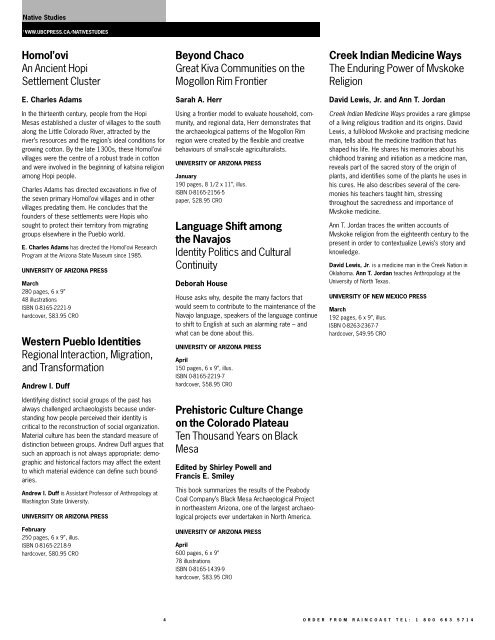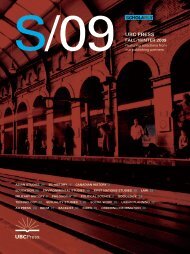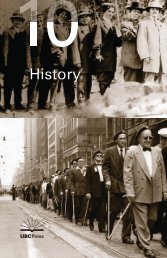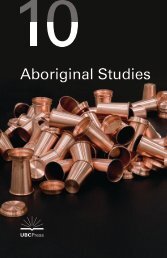Complete Catalogue Spring Summer 2002 UBCPressand Agencies
Complete Catalogue Spring Summer 2002 UBCPressand Agencies
Complete Catalogue Spring Summer 2002 UBCPressand Agencies
Create successful ePaper yourself
Turn your PDF publications into a flip-book with our unique Google optimized e-Paper software.
Native Studies<br />
WWW.UBCPRESS.CA/NATIVESTUDIES<br />
Homol’ovi<br />
An Ancient Hopi<br />
Settlement Cluster<br />
E. Charles Adams<br />
In the thirteenth century, people from the Hopi<br />
Mesas established a cluster of villages to the south<br />
along the Little Colorado River, attracted by the<br />
river’s resources and the region’s ideal conditions for<br />
growing cotton. By the late 1300s, these Homol’ovi<br />
villages were the centre of a robust trade in cotton<br />
and were involved in the beginning of katsina religion<br />
among Hopi people.<br />
Charles Adams has directed excavations in five of<br />
the seven primary Homol’ovi villages and in other<br />
villages predating them. He concludes that the<br />
founders of these settlements were Hopis who<br />
sought to protect their territory from migrating<br />
groups elsewhere in the Pueblo world.<br />
E. Charles Adams has directed the Homol’ovi Research<br />
Program at the Arizona State Museum since 1985.<br />
UNIVERSITY OF ARIZONA PRESS<br />
March<br />
280 pages, 6 x 9”<br />
48 illustrations<br />
ISBN 0-8165-2221-9<br />
hardcover, $83.95 CRO<br />
Western Pueblo Identities<br />
Regional Interaction, Migration,<br />
and Transformation<br />
Andrew I. Duff<br />
Identifying distinct social groups of the past has<br />
always challenged archaeologists because understanding<br />
how people perceived their identity is<br />
critical to the reconstruction of social organization.<br />
Material culture has been the standard measure of<br />
distinction between groups. Andrew Duff argues that<br />
such an approach is not always appropriate: demographic<br />
and historical factors may affect the extent<br />
to which material evidence can define such boundaries.<br />
Andrew I. Duff is Assistant Professor of Anthropology at<br />
Washington State University.<br />
UNIVERSITY OR ARIZONA PRESS<br />
February<br />
250 pages, 6 x 9”, illus.<br />
ISBN 0-8165-2218-9<br />
hardcover, $80.95 CRO<br />
Beyond Chaco<br />
Great Kiva Communities on the<br />
Mogollon Rim Frontier<br />
Sarah A. Herr<br />
Using a frontier model to evaluate household, community,<br />
and regional data, Herr demonstrates that<br />
the archaeological patterns of the Mogollon Rim<br />
region were created by the flexible and creative<br />
behaviours of small-scale agriculturalists.<br />
UNIVERSITY OF ARIZONA PRESS<br />
January<br />
190 pages, 8 1/2 x 11”, illus.<br />
ISBN 0-8165-2156-5<br />
paper, $28.95 CRO<br />
Language Shift among<br />
the Navajos<br />
Identity Politics and Cultural<br />
Continuity<br />
Deborah House<br />
House asks why, despite the many factors that<br />
would seem to contribute to the maintenance of the<br />
Navajo language, speakers of the language continue<br />
to shift to English at such an alarming rate – and<br />
what can be done about this.<br />
UNIVERSITY OF ARIZONA PRESS<br />
April<br />
150 pages, 6 x 9”, illus.<br />
ISBN 0-8165-2219-7<br />
hardcover, $58.95 CRO<br />
Prehistoric Culture Change<br />
on the Colorado Plateau<br />
Ten Thousand Years on Black<br />
Mesa<br />
Edited by Shirley Powell and<br />
Francis E. Smiley<br />
This book summarizes the results of the Peabody<br />
Coal Company’s Black Mesa Archaeological Project<br />
in northeastern Arizona, one of the largest archaeological<br />
projects ever undertaken in North America.<br />
UNIVERSITY OF ARIZONA PRESS<br />
April<br />
600 pages, 6 x 9”<br />
78 illustrations<br />
ISBN 0-8165-1439-9<br />
hardcover, $83.95 CRO<br />
Creek Indian Medicine Ways<br />
The Enduring Power of Mvskoke<br />
Religion<br />
David Lewis, Jr. and Ann T. Jordan<br />
Creek Indian Medicine Ways provides a rare glimpse<br />
of a living religious tradition and its origins. David<br />
Lewis, a full-blood Mvskoke and practising medicine<br />
man, tells about the medicine tradition that has<br />
shaped his life. He shares his memories about his<br />
childhood training and initiation as a medicine man,<br />
reveals part of the sacred story of the origin of<br />
plants, and identifies some of the plants he uses in<br />
his cures. He also describes several of the ceremonies<br />
his teachers taught him, stressing<br />
throughout the sacredness and importance of<br />
Mvskoke medicine.<br />
Ann T. Jordan traces the written accounts of<br />
Mvskoke religion from the eighteenth century to the<br />
present in order to contextualize Lewis’s story and<br />
knowledge.<br />
David Lewis, Jr. is a medicine man in the Creek Nation in<br />
Oklahoma. Ann T. Jordan teaches Anthropology at the<br />
University of North Texas.<br />
UNIVERSITY OF NEW MEXICO PRESS<br />
March<br />
192 pages, 6 x 9”, illus.<br />
ISBN 0-8263-2367-7<br />
hardcover, $49.95 CRO<br />
4<br />
ORDER FROM RAINCOAST TEL: 1 800 663 5714






